Solar System: Things To Know This Week
Solar System: Things to Know This Week
From the people who work for us, to ESA’s ExoMars, to phases of the moon, learn more about the solar system.
1. NASA Is More Than Astronauts

Our employees engage in a very wide range of work, and they come from a variety of backgrounds. To meet some of them and learn how they came to work for us, follow the #NASAProud tag on social media.
+ Learn about job opportunities and why NASA employees love working there + Get to know the people who explore the solar system
2. ExoMars Is Cleared for Landing

A joint project between the European Space Agency and Russia's Roscosmos space agency, ExoMars 2016 will enter orbit around the Red Planet on Oct. 19. The mission includes the Trace Gas Orbiter (TGO) and the Schiaparelli entry, descent and landing demonstrator. TGO will make a detailed inventory of Mars' atmospheric gases, looking especially for rare gases like methane to help determine whether that methane stems from a geological or biological source. The orbiter also carries a pair of transmitters provided by NASA. The Schiaparelli lander separated from TGO on Oct. 16, entering the atmosphere for a six-minute descent to a region in Meridiani Planum, not far from NASA's Opportunity rover. Schiaparelli will test landing technologies in preparation for future missions, including a heatshield, parachute, propulsion system and a crushable structure.
+ Go along for the ride
3. This Just in From Jupiter

Mission managers for our Juno mission to Jupiter have decided to postpone the burn of its main rocket motor originally scheduled for Oct. 19. Engineers want to carefully examine telemetry from a pair of sticky helium valves before the maneuver, which will reduce the time it takes Juno to orbit Jupiter from about 53 days to 14 days. The next opportunity for the burn would be during its close flyby of Jupiter on Dec. 11. Meanwhile, the spacecraft is still gathering data about Jupiter, and Juno will still swing close by the giant planet on Oct. 19.
+ Read more
4. It's Just a Phase

The moon was full on Oct. 16. This month's full moon is sometimes called the Harvest Moon or Hunter's Moon.
+ See a video showing all of this year's lunar + Learn what causes the moon's phases
5. Free to Ride

Did you know that NASA offers several other fascinating (and free) online experiences, all based on actual data from real missions. Here are a few to explore:
+ Mars Trek + Vesta Trek + Lunaserv Global Explorer + Deep Space Network (DSN) Now + Spacecraft 3D app
Discover the full list of 10 things to know about our solar system this week HERE.
Make sure to follow us on Tumblr for your regular dose of space: http://nasa.tumblr.com
More Posts from Nasa and Others
Solar System: Things to Know This Week
Has Cassini inspired you? Learn more about dwarf planet Ceres, get the latest images from the Keck Observatory and more!

1. Has Cassini Inspired You?
During nearly two decades in space, Cassini has been a source of inspiration to many. Has Cassini inspired you? Upload your artwork, photos, poems or songs to the social media platform of your choice, such as Instagram, YouTube, Facebook, Twitter or others. Tag it #CassiniInspires. Or, send it directly to: cassinimission@jpl.nasa.gov. We'll highlight some of the creations on this page. See examples and details at: saturn.jpl.nasa.gov/mission/cassiniinspires/

2. Dawn’s Shines a Light on Ceres
Our Dawn mission has found evidence for organic material on Ceres, a dwarf planet and the largest body in the main asteroid belt between Mars and Jupiter. Learn more: solarsystem.nasa.gov/news/2017/02/17/dawn-discovers-evidence-for-organic-material-on-ceres

3. Into the Vortex
A new device called the vortex coronagraph was recently installed inside NIRC2 (Near Infrared Camera 2) at the W.M. Keck Observatory in Hawaii and has delivered its first images, showing a ring of planet-forming dust around a star, and separately, a cool, star-like body, called a brown dwarf, lying near its companion star.
4. Enceladus: Cassini Cracks the Code of the Icy Moon
A puzzling sensor reading transformed our Cassini Saturn mission and created a new target in the search for habitable worlds beyond Earth, when on Feb. 17, 2005, Cassini made the first-ever close pass over Saturn’s moon. Since our two Voyager spacecraft made their distant flybys of Enceladus about 20 years prior, scientists had anticipated the little moon would be an interesting place to visit. Enceladus is bright white -- the most reflective object in the solar system, in fact -- and it orbits in the middle of a faint ring of dust-sized ice particles known as Saturn’s E ring. Scientists speculated ice dust was being kicked off its surface somehow. But they presumed it would be, essentially, a dead, airless ball of ice.
What Cassini saw didn't look like a frozen, airless body. Instead, it looked something like a comet that was actively emitting gas. The magnetometer detected that Saturn’s magnetic field, which envelops Enceladus, was perturbed above the moon's south pole in a way that didn't make sense for an inactive world. Could it be that the moon was actively replenishing gases it was breathing into space? Watch the video.

5. Descent Into a Frozen Underworld
Our planet's southernmost active volcano reaches 12,448 feet (3,794 meters) above Ross Island in Antarctica. It's a good stand-in for a frozen alien world, the kind we want to send robots to someday. Learn more: solarsystem.nasa.gov/news/2017/02/13/descent-into-a-frozen-underworld
Discover the full list of 10 things to know about our solar system this week HERE.
Follow us on Tumblr for your regular dose of space: http://nasa.tumblr.com

#TBT to 1989 when Voyager 2 spotted Uranus looking like a seemingly perfect robin’s egg. 💙 When our Voyager 2 spacecraft flew by it in this image, one pole was pointing directly at the Sun. This means that no matter how much it spins, one half is completely in the sun at all times, and the other half is in total darkness.. Far-flung, Uranus – an ice giant of our solar system – is as mysterious as it is distant. Soon after its launch in 2021, our James Webb Space Telescope will change that by unlocking secrets of its atmosphere. Image Credit: NASA/JPL-Caltech
Make sure to follow us on Tumblr for your regular dose of space: http://nasa.tumblr.com
What Does Two Decades of Rain and Snow Show Us?
You are seeing the culmination of almost twenty years of rain and snow, all at once.

For the first time, we have combined and remastered the satellite measurements from two of our precipitation spacecraft to create our most detailed picture of our planet’s rain and snowfall. This new record will help scientists better understand normal and extreme rain and snowfall around the world and how these weather events may change in a warming climate.

The Most Extreme Places on Earth
Using this new two-decade record, we can see the most extreme places on Earth.
The wettest places on our planet occur over oceans. These extremely wet locations tend to be very concentrated and over small regions.
A region off the coast of Indonesia receives on average 279 inches of rain per year.

An area off the coast of Colombia sees on average 360 inches of rain per year.

The driest places on Earth are more widespread. Two of the driest places on Earth are also next to cold ocean waters. In these parts of the ocean, it rains as little as it does in the desert -- they’re also known as ocean deserts!
Just two thousand miles to the south of Colombia is one of the driest areas, the Atacama Desert in Chile that receives on average 0.64 inches of rain per year.

Across the Atlantic Ocean, Namibia experiences on average 0.49 inches of rain a year and Egypt gets on average 0.04 inches of rain per year.

Global Patterns
As we move from January to December, we can see the seasons shift across the world.

During the summer in the Northern Hemisphere, massive monsoons move over India and Southeast Asia.

We can also see dynamic swirling patterns in the Southern Ocean, which scientists consider one of our planet’s last great unknowns.

Close-up Patterns
This new record also reveals typical patterns of rain and snow at different times of the day -- a pattern known as the diurnal cycle.
As the Sun heats up Earth’s surface during the day, rainfall occurs over land. In Florida, sea breezes from the Gulf of Mexico and Atlantic Ocean feed the storms causing them to peak in the afternoon. At night, storms move over the ocean.

In the winter months in the U.S. west coast, the coastal regions generally receive similar amounts of rain and snow throughout the day. Here, precipitation is driven less from the daily heating of the Sun and more from the Pacific Ocean bringing in atmospheric rivers -- corridors of intense water vapor in the atmosphere.

This new record marks a major milestone in the effort to generate a long-term record of rain and snow. Not only does this long record improve our understanding of rain and snow as our planet changes, but it is a vital tool for other agencies and researchers to understand and predict floods, landslides, disease outbreaks and agricultural production.
Make sure to follow us on Tumblr for your regular dose of space: http://nasa.tumblr.com
Solar System: Things to Explore on Your Phone This Week
Let our apps lead you on a journey of exploration across the Earth, through the solar system and beyond. Here are some to download today:
1. Actually, it is rocket science Rocket Science 101 let’s you select your favorite mission and build a rocket to take you to destinations near and far. Learn how launch vehicles are configured and how their boosters and other component parts work together to successfully launch spacecraft.
iOS Google Play

2. Go to Mars (sort of) Be A Martian lets you experience Mars as if you were there! Join an international community of explorers. See the latest images of the Red Planet! Learn about Mars, ask questions, and check out behind-the-scenes videos of the missions.
iOS Google Play

3. All the Earth science With Earth Now, watch Earth science satellites in real time as they gather data about our home planet. Get real-time images of the places we call home. Check out global climate data, including surface air temperature, carbon dioxide, carbon monoxide, ozone, and sea level variations.
iOS Google Play

4. Pretty pictures Discover stunning images and videos of our planet Earth, space, stars and planets with Space Images. Find your favorite galaxies and explore our celestial neighborhood.
iOS Google Play

5. Ch-ch-ch-changes Images of Change give you a close-up view of our ever-changing planet. Inside this app, before and after image pairs show areas that have been subject to natural disasters or seen significant change over time.
iOS

Last but not least: NASA on the go With our official NASA app, explore and discover the latest images, videos, mission information, news, feature stories, tweets, NASA TV and featured content from across America’s space program.
iOS Google Play

Our apps let you explore our latest images, videos,and mission news.
Discover the full list of 10 apps showcasing our solar system this week HERE.
Make sure to follow us on Tumblr for your regular dose of space: http://nasa.tumblr.com
First All-Woman Spacewalk

NASA astronauts and best friends, Christina Koch and Jessica Meir, made history Friday, October 18, 2019, by conducting the first all-woman spacewalk outside the International Space Station (ISS)! The Expedition 61 flight engineers ventured into the vacuum of space at 7:38 a.m. EDT to swap out a failed power controller that regulates the batteries used to collect and distribute power to the orbital laboratory – a task that took a total of seven hours and 17 minutes to complete.
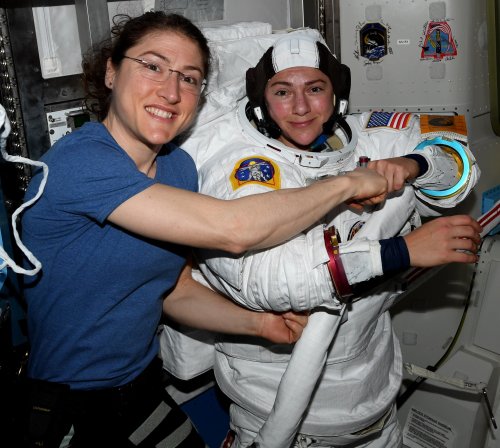
This was Koch’s fourth spacewalk and Meir’s first. Both women, selected as astronaut candidates in 2013, are on their first trip to work and live aboard the space station. Meir will be the 15th woman to spacewalk, and the 14th U.S. woman.
Get to know the astronauts
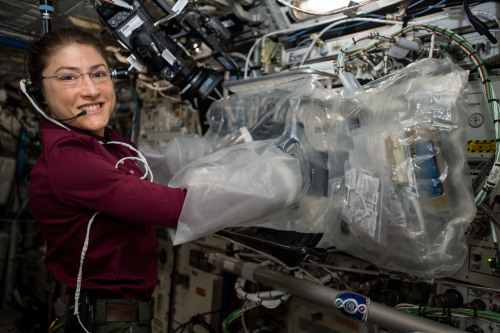
In addition to being an astronaut, Christina Koch is an engineer and physicist. Her career has taken her to extreme parts of the planet to conduct scientific field missions in places like the Antarctic South Pole and Greenland’s Summit Station. Prior to being selected as an astronaut candidate in 2013, she worked as an Electrical Engineer at our Goddard Space Flight Center’s Laboratory for High Energy Astrophysics.
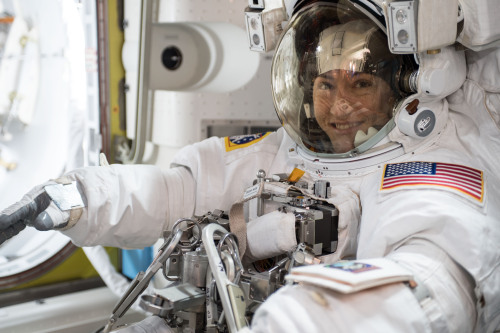
Koch left Earth on March 14, 2019, and is slated to set a record for the longest single spaceflight by a woman with an expected total of 328 days in space. Her extended mission will provide researchers the opportunity to observe the effects of long-duration spaceflight on a female body in preparation for human missions to the Moon and Mars.

Jessica Meir dreamed of the day she would make it to space since the age of five. That dream became a reality on Wednesday, Sept. 25, 2019 as she left Earth on her first spaceflight – later floating into her new home aboard the International Space Station.
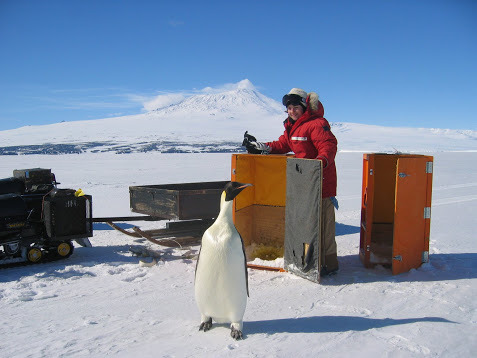
While Meir’s new home is more than 200 miles over the Earth, she is no stranger to extreme environments. She studied penguins in Antarctica and mapped caves in Italy – both of which prepared her for the ultimate extreme environment: space.
#AllWomanSpacewalk, what’s the deal?
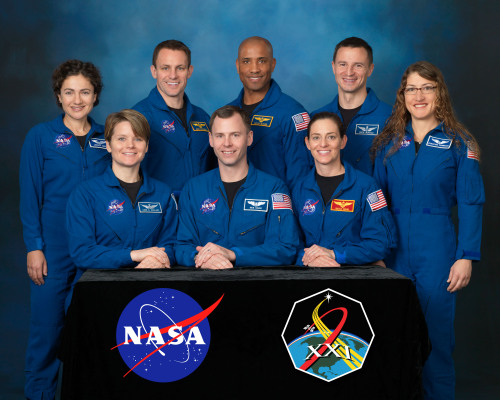
The all-woman spacewalk wasn’t something we purposefully planned; it is a testament to the increasing number of female astronauts in the space program. For example, Koch’s and Meir’s 2013 class of astronaut candidates was 50 percent women!
When asked in an interview about the importance of conducting her mission and this spacewalk, Koch said,
“In the end, I do think it’s important, and I think it’s important because of the historical nature of what we’re doing. In the past women haven’t always been at the table. It’s wonderful to be contributing to the space program at a time when all contributions are being accepted, when everyone has a role. That can lead in turn to increased chance for success. There are a lot of people who derive motivation from inspiring stories of people who look like them, and I think it’s an important story to tell.”
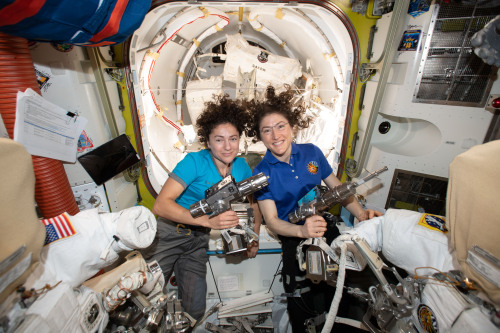
It’s important to note that spacewalks are not easy; astronauts typically describe them as the most physically challenging thing they do. Assignments are made on the basis of which astronauts are the best prepared to accomplish the tasks at hand under the conditions at the time. Today, Koch and Meir were the top astronauts for the job.
Women are no stranger to spacewalks!

While this was the first spacewalk to be conducted entirely by women, women are no strangers to spacewalks. Exactly 35 years and one week ago, Kathryn Sullivan (pictured above) made her own historic debut as the first U.S. woman to conduct a spacewalk. Since then, a total of 14 women (15 including Jessica) have ventured into the vacuum of space on 40 different spacewalks. Former Astronaut Peggy Whitson performed a record number of 10! From Astronauts to mission directors, women have been making their mark at the agency for decades now. A few of our recent pioneers are:
Astronaut Kate Rubins: First person to sequence DNA in space
Astronaut Peggy Whitson: First woman to command the ISS
Sandra Cauffman: Director of our Earth Science’s Division
Nicola Fox: Director of our Heliophysics Division
Lori Glaze: Director of our Planetary Science Division
Coming soon: The first woman to walk on the Moon

The first all-woman spacewalk is a milestone worth noting and celebrating as we look forward to putting the first woman and the next man on the Moon by 2024 with our Artemis lunar exploration program. With today’s historic event, we once again set a precedence for women to lead in space exploration.
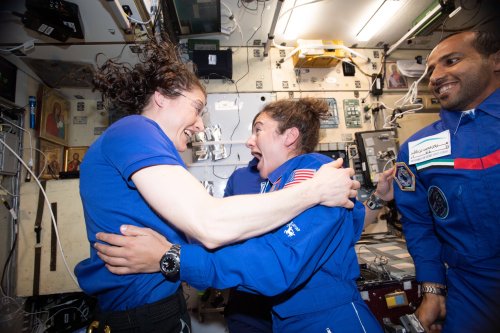
We hope achievements such as this provide inspiration to you all around the world, proving that hard work can lead you to great heights. This is not just a historic day for NASA, but a moment we can all feel proud of.
Didn’t have time to tune in? Check out the replay, here. Koch was wearing the spacesuit with red stripes, while Meir’s had no stripes.
If you’d like to keep up with Christian Koch and Jessica Meir’s work 254 miles above planet Earth, follow them on Twitter at @Astro_ Christina and @Astro_Jessica.
Be sure to follow us on Tumblr for your regular dose of space: http://nasa.tumblr.com
Sounding Rocket Science in the Arctic
We sent three suborbital sounding rockets right into the auroras above Alaska on the evening of March 1 local time from the Poker Flat Research Range north of Fairbanks, Alaska.

Sounding rockets are suborbital rockets that fly up in an arc and immediately come back down, with a total flight time around 20 minutes.

Though these rockets don’t fly fast enough to get into orbit around Earth, they still give us valuable information about the sun, space, and even Earth itself. Sounding rockets’ low-cost access to space is also ideal for testing instruments for future satellite missions.
Sounding rockets fly above most of Earth’s atmosphere, allowing them to see certain types of light – like extreme ultraviolet and X-rays – that don’t make it all the way to the ground because they are absorbed by the atmosphere. These kinds of light give us a unique view of the sun and processes in space.

The sun seen in extreme ultraviolet light by the Solar Dynamics Observatory satellite.
Of these three rockets, two were part of the Neutral Jets in Auroral Arcs mission, collecting data on winds influenced by the electric fields related to auroras. Sounding rockets are the perfect vehicle for this type of study, since they can fly directly through auroras – which exist in a region of Earth’s upper atmosphere too high for scientific balloons, but too low for satellites.

The third rocket that launched on March 1 was part of the ISINGLASS mission (short for Ionospheric Structuring: In Situ and Ground-based Low Altitude Studies). ISINGLASS included two rockets designed to launch into two different types of auroras in order to collect detailed data on their structure, with the hope of better understanding the processes that create auroras. The initial ISINGLASS rocket launched a few weeks earlier, on Feb. 22, also from the Poker Flat Research Range in Alaska.

Auroras are caused when charged particles trapped in Earth’s vast magnetic field are sent raining down into the atmosphere, usually triggered by events on the sun that propagate out into space.
Team members at the range had to wait until conditions were just right until they could launch – including winds, weather, and science conditions. Since these rockets were studying aurora, that means they had to wait until the sky was lit up with the Northern Lights.

Regions near the North and South Pole are best for studying the aurora, because the shape of Earth’s magnetic field naturally funnels aurora-causing particles near the poles.
But launching sensitive instruments near the Arctic Circle in the winter has its own unique challenges. For example, rockets have to be insulated with foam or blankets every time they’re taken outside – including while on the launch pad – because of the extremely low temperatures.

For more information on sounding rockets, visit www.nasa.gov/soundingrockets.
Make sure to follow us on Tumblr for your regular dose of space: http://nasa.tumblr.com
10 Things: Mars Helicopter
When our next Mars rover lands on the Red Planet in 2021, it will deliver a groundbreaking technology demonstration: the first helicopter to ever fly on a planetary body other than Earth. This Mars Helicopter will demonstrate the first controlled, powered, sustained flight on another world. It could also pave the way for future missions that guide rovers and gather science data and images at locations previously inaccessible on Mars. This exciting new technology could change the way we explore Mars.

1. Its body is small, but its blades are mighty.
One of the biggest engineering challenges is getting the Mars Helicopter’s blades just right. They need to push enough air downward to receive an upward force that allows for thrust and controlled flight — a big concern on a planet where the atmosphere is only one percent as dense as Earth’s. “No helicopter has flown in those flight conditions – equivalent to 100,000 feet (30,000 meters) on Earth,” said Bob Balaram, chief engineer for the project at our Jet Propulsion Laboratory.

2. It has to fly in really thin Martian air.
To compensate for Mars’ thin atmosphere, the blades must spin much faster than on an Earth helicopter, and the blade size relative to the weight of the helicopter has to be larger too. The Mars Helicopter’s rotors measure 4 feet wide (about 1.2 meters) long, tip to tip. At 2,800 rotations per minute, it will spin about 10 times faster than an Earth helicopter. At the same time, the blades shouldn’t flap around too much, as the helicopter’s design team discovered during testing. Their solution: make the blades more rigid. “Our blades are much stiffer than any terrestrial helicopter’s would need to be,” Balaram said. The body, meanwhile, is tiny — about the size of a softball. In total, the helicopter will weigh just under 4 pounds (1.8 kilograms).

3. It will make up to five flights on Mars.
Over a 30-day period on Mars, the helicopter will attempt up to five flights, each time going farther than the last. The helicopter will fly up to 90 seconds at a time, at heights of up to 10 to 15 feet (3 to 5 meters). Engineers will learn a lot about flying a helicopter on Mars with each flight, since it’s never been done before!

4. The Mars Helicopter team has already completed groundbreaking tests.
Because a helicopter has never visited Mars before, the Mars Helicopter team has worked hard to figure out how to predict the helicopter’s performance on the Red Planet. “We had to invent how to do planetary helicopter testing on Earth,” said Joe Melko, deputy chief engineer of Mars Helicopter, based at JPL.
The team, led by JPL and including members from JPL, AeroVironment Inc., Ames Research Center, and Langley Research Center, has designed, built and tested a series of test vehicles.
In 2016, the team flew a full-scale prototype test model of the helicopter in the 25-foot (7.6-meter) space simulator at JPL. The chamber simulated the low pressure of the Martian atmosphere. More recently, in 2018, the team built a fully autonomous helicopter designed to operate on Mars, and successfully flew it in the 25-foot chamber in Mars-like atmospheric density.
Engineers have also exercised the rotors of a test helicopter in a cold chamber to simulate the low temperatures of Mars at night. In addition, they have taken design steps to deal with Mars-like radiation conditions. They have also tested the helicopter’s landing gear on Mars-like terrain. More tests are coming to see how it performs with Mars-like winds and other conditions.

5. The camera is as good as your cell phone camera.
The helicopter’s first priority is successfully flying on Mars, so engineering information takes priority. An added bonus is its camera. The Mars Helicopter has the ability to take color photos with a 13-megapixel camera — the same type commonly found in smart phones today. Engineers will attempt to take plenty of good pictures.
6. It’s battery-powered, but the battery is rechargeable.
The helicopter requires 360 watts of power for each second it hovers in the Martian atmosphere – equivalent to the power required by six regular lightbulbs. But it isn’t out of luck when its lithium-ion batteries run dry. A solar array on the helicopter will recharge the batteries, making it a self-sufficient system as long as there is adequate sunlight. Most of the energy will be used to keep the helicopter warm, since nighttime temperatures on Mars plummet to around minus 130 degrees Fahrenheit (minus 90 Celsius). During daytime flights, temperatures may rise to a much warmer minus 13 to minus 58 degrees Fahrenheit to (minus 25 to minus 50 degrees Celsius) — still chilly by Earth standards. The solar panel makes an average of 3 watts of power continuously during a 12-hour Martian day.
7. The helicopter will be carried to Mars under the belly of the rover.
Somewhere between 60 to 90 Martian days (or sols) after the Mars 2020 rover lands, the helicopter will be deployed from the underside of the rover. Mars Helicopter Delivery System on the rover will rotate the helicopter down from the rover and release it onto the ground. The rover will then drive away to a safe distance.

8. The helicopter will talk to the rover.
The Mars 2020 rover will act as a telecommunication relay, receiving commands from engineers back on Earth and relaying them to the helicopter. The helicopter will then send images and information about its own performance to the rover, which will send them back to Earth. The rover will also take measurements of wind and atmospheric data to help flight controllers on Earth.
9. It has to fly by itself, with some help.
Radio signals take time to travel to Mars — between four and 21 minutes, depending on where Earth and Mars are in their orbits — so instantaneous communication with the helicopter will be impossible. That means flight controllers can’t use a joystick to fly it in real time, like a video game. Instead, they need to send commands to the helicopter in advance, and the little flying robot will follow through. Autonomous systems will allow the helicopter to look at the ground, analyze the terrain to look how fast it’s moving, and land on its own.
10. It could pave the way for future missions.
A future Mars helicopter could scout points of interest, help scientists and engineers select new locations and plan driving routes for a rover. Larger standalone helicopters could carry science payloads to investigate multiple sites at Mars. Future helicopters could also be used to fly to places on Mars that rovers cannot reach, such as cliffs or walls of craters. They could even assist with human exploration one day. Says Balaram: "Someday, if we send astronauts, these could be the eyes of the astronauts across Mars.”
Read the full version of this week’s ‘10 Things to Know’ article on the web HERE.
Make sure to follow us on Tumblr for your regular dose of space: http://nasa.tumblr.com.

Ever want to ask a real life astronaut a question? Here’s your chance!
Astronaut Jeanette Epps will be taking your questions in an Answer Time session on Friday, May 5 from 10am - 11am ET here on NASA’s Tumblr. See the questions she’s answered by visiting nasa.tumblr.com/tagged/answertime!
NASA astronaut Jeanette J. Epps (Ph.D.) was selected as an astronaut in 2009. She has been assigned to her first spaceflight, which is scheduled to launch in May 2018. Her training included scientific and technical briefings, intensive instruction in International Space Station systems, spacewalk training, robotics, T‐38 flight training and wilderness survival training.
Before becoming an astronaut, Epps worked as a Technical Intelligence Officer at the Central Intelligence Agency (CIA).
Born in Syracuse, New York. Enjoys traveling, reading, running, mentoring, scuba diving and family.
She has a Bachelor of Science in Physics from LeMoyne College, as well as a Master of Science and Doctorate of Philosophy in Aerospace Engineering from the University of Maryland.
Follow Jeanette on Twitter at @Astro_Jeanette and follow NASA on Tumblr for your regular dose of space.
Countdown to Calving at Antarctica's Brunt Ice Shelf

Cracks growing across Antarctica’s Brunt Ice Shelf are poised to release an iceberg with an area about twice the size of New York City, (about 604 square miles). It is not yet clear how the remaining ice shelf will respond following the break, posing an uncertain future for scientific infrastructure and a human presence on the shelf that was first established in 1955.

NASA Earth Observatory image by Joshua Stevens, using Landsat data from the U.S. Geological Survey. Story by Kathryn Hansen, with image interpretation by Chris Shuman (NASA/UMBC).
The above image, from the Operational Land Imager (OLI) on Landsat 8, shows the area on January 23, 2019. The crack along the top of the image—the so-called Halloween crack—first appeared in late October 2016 and continues to grow eastward from an area known as the McDonald Ice Rumples. The rumples are due to the way ice flows over an underwater formation, where the bedrock rises high enough to reach into the underside of the ice shelf. This rocky formation impedes the flow of ice and causes pressure waves, crevasses, and rifts to form at the surface.
The more immediate concern is the rift visible in the center of the image. Previously stable for about 35 years, this crack recently started accelerating northward as fast as 4 kilometers per year.
Calving is a normal part of the life cycle of ice shelves, but the recent changes are unfamiliar in this area. The edge of the Brunt Ice Shelf has evolved slowly since Ernest Shackleton surveyed the coast in 1915, but it has been speeding up in the past several years.
Make sure to follow us on Tumblr for your regular dose of space: http://nasa.tumblr.com
What’s Up for July 2016?

What's Up for July? Use Saturn as your guide to a tour of the summer Milky Way.

Saturn continues to dazzle this month. Its wide rings and golden color provide a nice contrast to nearby Mars and Antares. Below Saturn lies the constellation Scorpius, which really does look like a scorpion!

Through binoculars or telescopes you'll be able to spot two pretty star clusters: a compact (or globular) cluster, M-4, and an open cluster, M-7. M-7 is known as Ptolemy's cluster. It was observed and cataloged by Greek-Egyptian astronomer Ptolemy in the first century.

Climbing north, you'll be able to spot the teapot shape which forms part of the constellation Sagittarius. The center of the Milky Way is easy to see. It looks like bright steam rising from the teapot's spout.

With difficulty, a good star chart and a medium-sized telescope you can locate faint Pluto in the "teaspoon" adjacent to the teapot.

A binocular tour of this center core of the Milky Way reveals many beautiful summer sky objects. We first encounter the Eagle Nebula, M-16. Part of this nebula is featured in the famous and beautiful "Pillars of Creation" images taken by our Hubble Space Telescope.

You'll have to stay up later to see the northern Milky Way constellations, which are better placed for viewing later in the summer and fall. Cygnus the swan features the prettiest supernova remnant in the entire sky, the Veil Nebula. It's too big to fit in one eyepiece view, but luckily there are three sections of it.

Look between Aquila and Cygnus to find three tiny constellations: Delphinus the dolphin, Vulpecula the fox and Lyra the lyre (or harp). M-57, the Ring Nebula, is the remains from a shell of ionized gas expelled by a red giant star into the surrounding interstellar medium. It's pretty, too! Look in Vulpecula for the Dumbbell, another planetary nebula.

We'll end our summer tour with Lacerta the lizard and Draco the Dragon. Lacerta is home to a star with an extrasolar planet in its orbit, and Draco, facing away from the center of our Milky Way, is a treasure trove of distant galaxies to catch in your telescope.
Watch the full What’s Up for July 2016 video HERE.
You can catch up on current missions and space telescopes studying our Milky Way and beyond at www.nasa.gov.
Make sure to follow us on Tumblr for your regular dose of space: http://nasa.tumblr.com
-
 astra-peraspera reblogged this · 6 years ago
astra-peraspera reblogged this · 6 years ago -
 deathisgivingmeaheadache liked this · 7 years ago
deathisgivingmeaheadache liked this · 7 years ago -
 anaadelainnerstar reblogged this · 8 years ago
anaadelainnerstar reblogged this · 8 years ago -
 anaadelainnerstar liked this · 8 years ago
anaadelainnerstar liked this · 8 years ago -
 bumfuzzledreferences reblogged this · 8 years ago
bumfuzzledreferences reblogged this · 8 years ago -
 anthropl liked this · 8 years ago
anthropl liked this · 8 years ago -
 best-hotels-posts reblogged this · 8 years ago
best-hotels-posts reblogged this · 8 years ago -
 kjfulton liked this · 8 years ago
kjfulton liked this · 8 years ago -
 turalahmadsoy liked this · 8 years ago
turalahmadsoy liked this · 8 years ago -
 28jquiroz liked this · 8 years ago
28jquiroz liked this · 8 years ago -
 alicerobertstext reblogged this · 8 years ago
alicerobertstext reblogged this · 8 years ago -
 annalindastarhederer reblogged this · 8 years ago
annalindastarhederer reblogged this · 8 years ago -
 annalindastarhederer liked this · 8 years ago
annalindastarhederer liked this · 8 years ago -
 oniwoolf-blog liked this · 8 years ago
oniwoolf-blog liked this · 8 years ago -
 xstarspiritsx liked this · 8 years ago
xstarspiritsx liked this · 8 years ago -
 dreadforks reblogged this · 8 years ago
dreadforks reblogged this · 8 years ago -
 dreadforks liked this · 8 years ago
dreadforks liked this · 8 years ago -
 whitepandaking liked this · 8 years ago
whitepandaking liked this · 8 years ago -
 superdonnaworld liked this · 8 years ago
superdonnaworld liked this · 8 years ago -
 dorothyholder liked this · 8 years ago
dorothyholder liked this · 8 years ago -
 cosmicfaeriewitch reblogged this · 8 years ago
cosmicfaeriewitch reblogged this · 8 years ago -
 cosmicfaeriewitch liked this · 8 years ago
cosmicfaeriewitch liked this · 8 years ago -
 eyewisheyewasdead liked this · 8 years ago
eyewisheyewasdead liked this · 8 years ago -
 dalrel liked this · 8 years ago
dalrel liked this · 8 years ago -
 starsaremymuse reblogged this · 8 years ago
starsaremymuse reblogged this · 8 years ago -
 soitgoestan-blog liked this · 8 years ago
soitgoestan-blog liked this · 8 years ago -
 classic-goal liked this · 8 years ago
classic-goal liked this · 8 years ago -
 riderbk liked this · 8 years ago
riderbk liked this · 8 years ago -
 ironhidesdaughter-blog reblogged this · 8 years ago
ironhidesdaughter-blog reblogged this · 8 years ago -
 politicalmovement-blog liked this · 8 years ago
politicalmovement-blog liked this · 8 years ago -
 sixthrangerknight reblogged this · 8 years ago
sixthrangerknight reblogged this · 8 years ago -
 8ronn liked this · 8 years ago
8ronn liked this · 8 years ago -
 quixoticanon reblogged this · 8 years ago
quixoticanon reblogged this · 8 years ago -
 cobaltash reblogged this · 8 years ago
cobaltash reblogged this · 8 years ago -
 broomykink reblogged this · 8 years ago
broomykink reblogged this · 8 years ago -
 foxy-voxy reblogged this · 8 years ago
foxy-voxy reblogged this · 8 years ago -
 mountaineerfox75-blog liked this · 8 years ago
mountaineerfox75-blog liked this · 8 years ago -
 kairav-blog liked this · 8 years ago
kairav-blog liked this · 8 years ago -
 scorpionatl-blog reblogged this · 8 years ago
scorpionatl-blog reblogged this · 8 years ago -
 sanny1956x liked this · 8 years ago
sanny1956x liked this · 8 years ago -
 reekstack liked this · 8 years ago
reekstack liked this · 8 years ago -
 boldlyunadulteratedparadise reblogged this · 8 years ago
boldlyunadulteratedparadise reblogged this · 8 years ago
Explore the universe and discover our home planet with the official NASA Tumblr account
1K posts